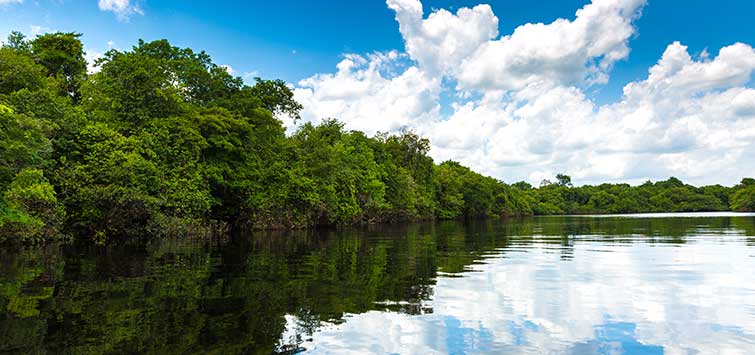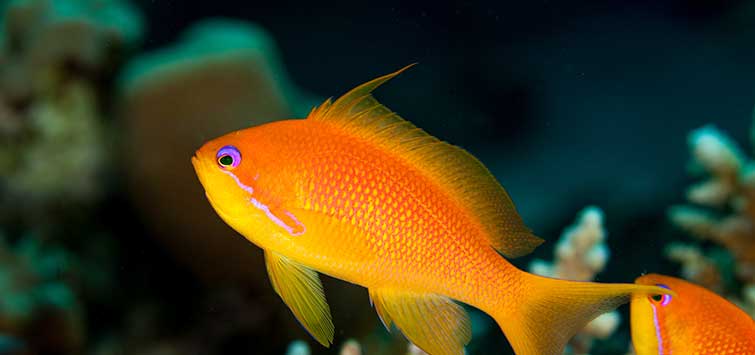An Amazon Adventure
Author: Johnny Jensen
An aquatic photographer takes us on a journey deep into the jungles of the Amazon to capture images of the amazing wildlife he encounters.
Making It to the AcarÍ River
We arrived at the AcarÍ River, a broad and murky river in the Madeira system, a little over 125 miles (200 km) south of Manaus. I had brought my son and five friends to this paradise, all intent on catching huge aquarium fish on rod and reel. The amphibious aircraft delivered us directly to the jungle base camp organized by PescAventura, with whom I had already had the pleasure of traveling several times.
After a lovely lunch under the jungle canopy and a morning of fishing for peacock bass, piranhas, and shovelnose catfish, we headed out again. Our stomachs were full of fried peacock bass, piranha soup, tomatoes, cucumbers, guaranÁ (the local Brazilian fruit drink), and a couple of ice-cold beers that we enjoyed in hammocks.
An Exotic, Colorful World
Our boat made a sharp turn up the tributary, and the guide pulled back on the power so as to minimize any disturbance in the clear, shallow water. Multi-spotted freshwater stingrays fled from our path, and schools of Leporinus headstanders darted past our boat. Suddenly the jungle closed in on us, and we entered the realm of wonders: An exotic world of crystal-clear water teeming with aquarium fish of all sizes and colors.
“Nature certainly does have a great decorator, right?” asked my son, and I agreed. Everywhere it looked like nature had arranged it so that everything looked pleasing to the eye. There were wonderful rapids with dark leaves on white sand, intense green plants swaying in the current, and fallen trees where fish schooled—all featured against a superb backdrop of palm trees, vines, and impenetrable jungle.
My time was well spent snorkeling through shoals of hundreds of Moenkhausia tetras and passing big pike cichlids and peacock bass. When I swam down, close to the bank, I came face-to-face with dwarf pike cichlids, apistos, checkerboard cichlids, eartheaters, headstanders, and even little caimans and turtles.
Taking Fish Photos
My own interests here were divided. As much as I loved catching fish with lures, I always felt guilty if I didn’t also concentrate on getting good pictures of the different species without hooks in their mouths. In the past, my fish photography efforts in the jungle had primarily revolved around taking photos to support my sport-fishing articles—showing, for example, baitfish or the variety of catchable fish species. The goal of those photos was really only for documentation purposes: a recently deceased fish laid out on a tree plank or held in my hand. For good aquarium photography, however, this system had to be improved upon considerably.
Fish Out of Water
A live fish is, of course, preferred for good photos, and such a fish can even be presented out of the water, on a wet surface for example; a wet wooden plank seems to be a fish-out-of-water standard of sorts when documenting a collecting trip. But better photographs feature the fish in water, which presents obvious challenges.
Underwater Photography
I have done quite a bit of underwater photography during my Amazon trips. Traveling to the Amazon is in itself an unbelievable experience, but the photography aspect really puts it over the top. It is like submerging yourself into a huge biotope aquarium with the most authentic selection of fish, plants, and general layout possible.
I have taken many nice photos while snorkeling in the clear-water tributaries, but as clear as the water may seem, it is never completely clear, and it is difficult and time-consuming to get a perfect underwater photo. Of course, such photographs reflect the reality of the river, but if you want the best fish photos, you really do have to use a photo tank.
Preparing the Photo Tank
And, lucky me, I had all the opportunities on this trip to create one. I had my own “travel tank” ready for adventure, but Rubinho de Almeida Prado, the owner of PescAventura, promised to bring a tank from Manaus. That meant less for me to pack and less that could go wrong. So I just brought a piece of artificial background and a tube of silicone adhesive.
The guides were happy to help out with everything. We cut the background to fit the tank, and I glued it in with the silicone. I collected mangrove-like roots from the trees around the camp and dead leaves from the river to decorate the tank. The roots were glued to the top of the background to look like the real thing, and the dead leaves became the substrate in place of sand or gravel, which can become a nuisance if the fish are bolting around.
Testing a New Camera
We collected clear water from one of the tributaries, and then we started the job of finding the right-size specimens of all the desired fish species. Here again, the guides were invaluable, catching all sorts of fish with small hooks and cast nets, and targeting areas they knew were good for various species. They even went out one night to catch me a handful of adult red Heckel discus (Symphysodon discus). On this trip I didn’t bring my big camera, even though I have a lot of experience handling it. Instead I wanted to try out my new, smaller waterproof camera. In general, I was happy with the new camera, but of course there were limits to how creative I could get without fiddling around too long in the menu screens.
I was very excited to see how well it would do when it came to the photo-tank shots. And, just as when I had tested it at home, there were absolutely no problems, aside from the usual challenges like shooting at an aquarium with an onboard flash; you have to angle the camera just right to avoid capturing the flash on the front glass.
The photo tank, its function well served, is currently in the care of Rubinho down in Manaus until next year, when there is no doubt we will return to the majestic Amazon to take even more jungle aquarium photos.

.png?h=595&iar=0&w=2781&hash=5FD5E69473BCC22199FBFA2FB71B6033)



